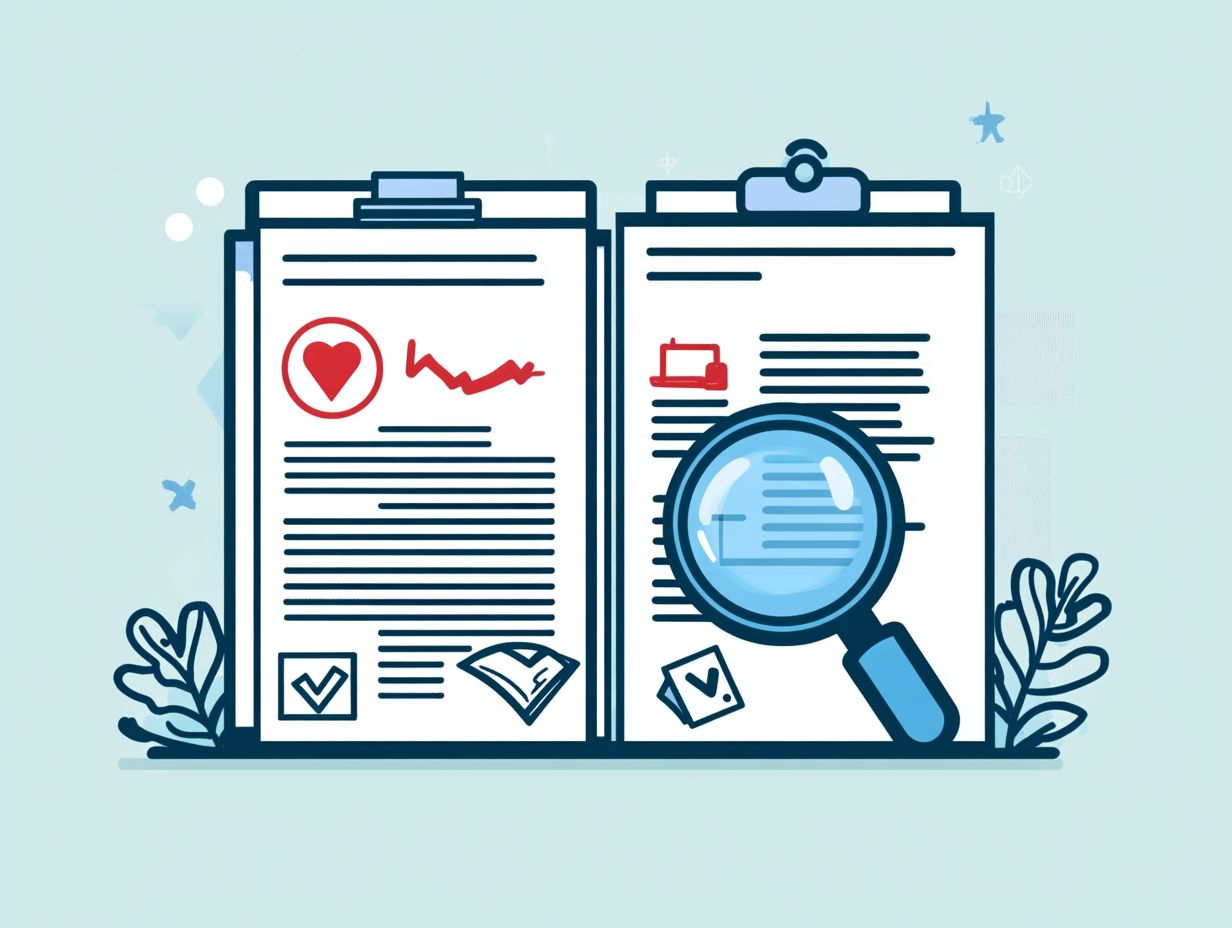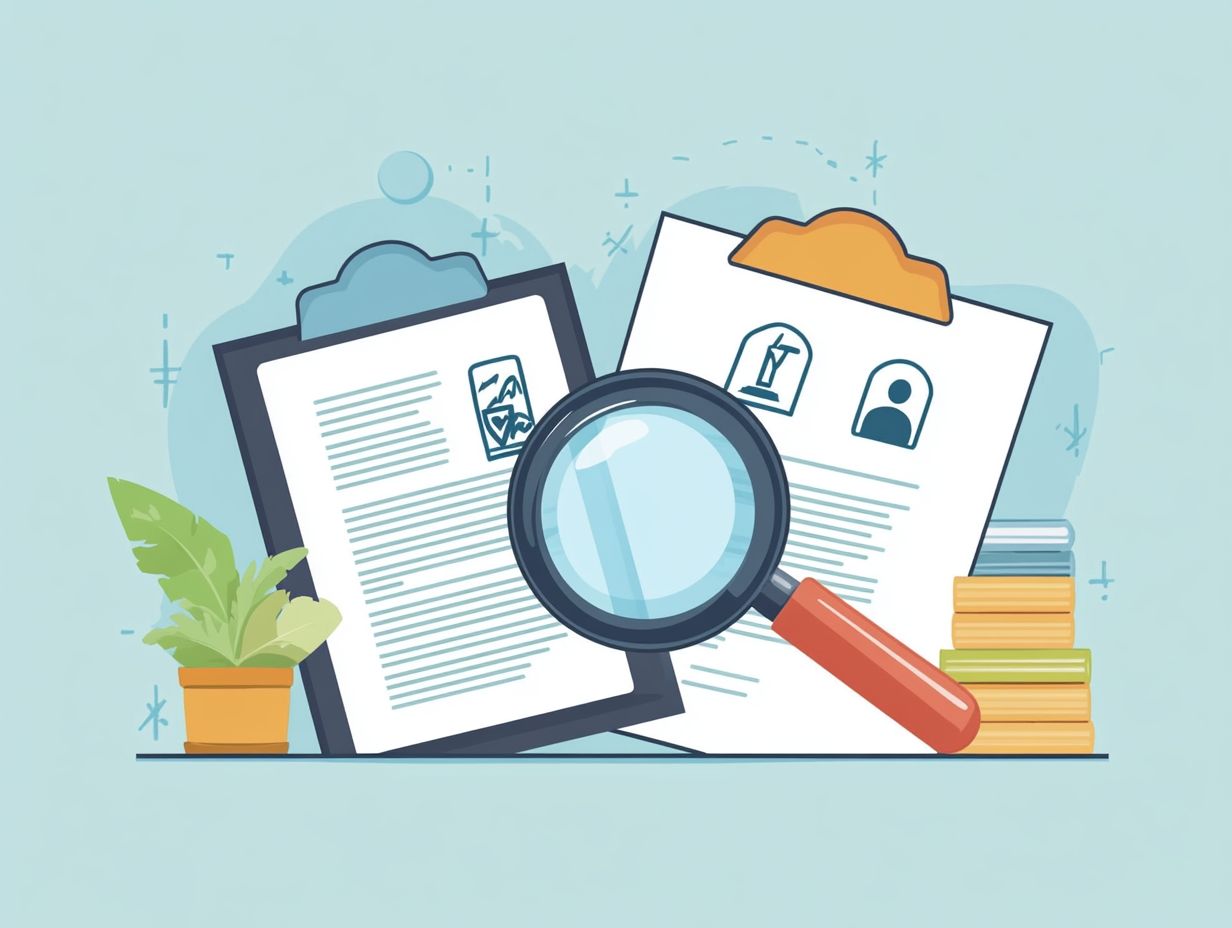Understanding the Differences in Policy Coverage
Navigating the intricacies of policy coverage can feel overwhelming, especially given the many terms and types you need to consider.
This article distills the essentials for you let s dive in! We begin with a clear definition of what policy coverage entails and the various forms it can take, including liability, property, and medical coverage.
You ll discover the factors that influence your coverage, from location to the nuances of your insurance provider.
You’ll also find valuable tips for maximizing your benefits and debunking common myths that might cloud your understanding.
Prepare to empower yourself with the knowledge you need to make informed decisions about policy coverage!
Contents
- Key Takeaways:
- Overview of Policy Coverage
- The Different Types of Policy Coverage
- Factors that Affect Policy Coverage
- Making the Most of Your Policy Coverage
- Common Misconceptions About Policy Coverage
- Frequently Asked Questions
- What is the purpose of understanding the differences in policy coverage?
- What are the common types of insurance policies?
- How do I know if a policy covers a specific event or situation?
- Can I combine different policies for better coverage?
- What factors should I consider when comparing policy coverage?
- What should I do if I am not satisfied with my current policy coverage?
Key Takeaways:

- The type of policy coverage you have can greatly impact the level of protection you receive in the event of a claim. It is important to understand the differences between liability, property, and medical coverage.
- Factors such as location, type of policy, and insurance company can all affect the extent of your policy coverage. It is crucial to carefully consider and review these factors when selecting a policy to ensure adequate protection.
- Maximizing your policy coverage can save you from unexpected financial burdens. Be proactive in understanding your coverage and follow tips such as reviewing your policy regularly, keeping accurate records, and reporting claims promptly.
Overview of Policy Coverage
Understanding policy coverage is crucial for you as a driver, as it safeguards you against the many risks that come with owning and operating a vehicle. For a deeper insight, you can explore the significance of coverage limits in various auto insurance policies like liability coverage, collision coverage, and comprehensive coverage, which offer different levels of protection tailored to your needs.
These policies address specific concerns such as bodily injury, property damage, medical payments, and situations involving uninsured motorists. Each of these elements can influence your premium costs and deductible amounts.
The right insurance coverage also includes vital protections like health insurance and homeowners insurance. This makes it essential for you to carefully evaluate your options to ensure comprehensive coverage that suits your lifestyle.
What is Policy Coverage?
Policy coverage refers to the protection your insurance policy offers against specific risks, giving you the power to manage your financial risk with confidence.
This concept is a cornerstone of risk management, allowing you to reduce possible losses that could arise from unforeseen circumstances.
There are various types of coverage designed to address different situations. For instance, liability coverage safeguards you against claims for injury or damage, while property coverage protects your valuable assets like homes and vehicles.
By grasping these distinctions, you can make informed decisions about your insurance services, ensuring you choose options that enhance your financial security and provide peace of mind in an unpredictable world.
The Different Types of Policy Coverage
The world of auto insurance is vast and multifaceted, offering a range of policy coverages tailored to meet your specific needs and shield you from potential financial setbacks.
At the core of it all is liability coverage, which protects you from damages in accidents where you re deemed at fault. Then there s collision coverage, which steps in to cover your vehicle s repair costs after an accident. Comprehensive coverage takes it a step further, guarding against non-collision-related incidents like theft or natural disasters.
Personal injury protection and medical payments ensure that medical expenses are covered for you and your passengers. Uninsured motorist coverage serves as a safety net, protecting you in the unfortunate event of an accident with a driver who lacks sufficient insurance.
Lastly, if you’re financing your vehicle, gap insurance is essential; it covers the difference between what your car is worth and what you still owe on your loan.
Liability Coverage
Liability coverage is an essential part of auto insurance, crafted to shield you from financial loss when you re found at fault for bodily injury or property damage in an accident.
This type of coverage takes care of expenses that arise if you injure another person or damage someone else’s property, ensuring you re not burdened with high costs. For example, if your actions lead to an accident resulting in $50,000 in medical bills for another party, liability coverage can help alleviate that financial strain.
While auto insurance policies typically set minimum liability limits, it s wise to consider opting for higher limits to truly safeguard yourself. With nearly 1 in 8 drivers on the road being uninsured, robust liability coverage is a must to protect yourself! An accident involving an uninsured driver could lead to significant financial repercussions for you, making this coverage not just a good idea, but a necessary one.
Property Coverage

Property coverage in auto insurance includes both collision and comprehensive coverage, effectively addressing various risks related to vehicle damage and loss.
Collision coverage safeguards against damages incurred when your vehicle collides with another vehicle or object, like a guardrail or a tree. If you often navigate crowded streets or drive at high speeds, this coverage is essential to mitigate the increased risk of accidents.
Comprehensive coverage, on the other hand, encompasses a range of non-collision events such as theft, vandalism, natural disasters like floods, hurricanes, or earthquakes, and animal strikes. This is a smart choice for your peace of mind, especially if you own newer or high-value vehicles.
By understanding these distinctions, you empower yourself to select the coverage that best aligns with your specific needs and driving habits.
Medical Coverage
Medical coverage in your auto insurance policy is vital for managing medical expenses that arise from vehicle accidents. It typically falls into two categories: medical payments and personal injury protection.
Understanding the difference between these two types of coverage is important for anyone navigating the roads. Medical payments coverage addresses immediate medical bills, ensuring that hospital visits and ambulance fees for you and your passengers are covered, regardless of fault. If you re injured in a collision while running an errand, this can help cover your urgent medical care.
Personal injury protection (PIP) goes beyond medical expenses, often including lost wages and rehabilitation costs. If you were unable to work due to your injuries from the same accident, PIP would cover your medical fees and a portion of your salary, providing financial stability as you recover.
Factors that Affect Policy Coverage
Several factors influence the type and extent of policy coverage available to you as a driver. These include your location, the specific type of policy you choose, and the insurance company underwriting your policy.
Location
Your location plays a crucial role in shaping your insurance coverage options and premium costs. Insurers assess regional risks tied to factors like crime rates, weather conditions, and road safety to determine your rates.
For example, urban areas typically have higher traffic congestion and an increased likelihood of accidents, resulting in elevated premiums compared to the more relaxed driving conditions found in rural settings.
State regulations also affect the mandatory coverage types and minimum liability limits you must adhere to. Insurance companies meticulously analyze historical data based on geographical trends to manage risk efficiently and adjust rates as needed.
This thorough assessment ensures that you are adequately protected against the unique hazards present in your locale. Thus, it s essential to grasp how the characteristics of your area can influence your overall insurance experience.
Type of Policy
The type of policy you select whether it s basic liability, full coverage, or specialized options will determine the extent of your protection and the costs of your premiums.
Opting for a basic liability policy typically offers just the minimum legal coverage required, which includes bodily injury and property damage. However, this choice often leaves you exposed to out-of-pocket expenses for damages that exceed those limits.
On the other hand, choosing full coverage means you ll benefit from comprehensive and collision insurance, granting you broader protection against various risks, including theft and accidents. However, this comes with higher premium costs.
If you re considering specialized options, like classic car coverage or rideshare insurance, it s essential to understand how these tailored policies influence your overall premiums and coverage limits. For instance, classic car insurance often factors in the vehicle’s agreed value, offering significant financial security while typically maintaining lower premiums than standard auto insurance.
Insurance Company

The choice of insurance company is pivotal in shaping the quality of services you receive and the premium costs you encounter as a policyholder. Navigating this decision can be complex due to the diverse offerings in the market.
Different insurers present various service levels, coverage types, and pricing structures that can leave you feeling overwhelmed. Key factors such as the insurer s reputation, customer service approach, and the specific policies they provide can profoundly impact your experience and financial outcomes.
For example, some companies might focus on niche areas like high-risk coverage or comprehensive health insurance, while others may excel with competitive pricing or a more personalized approach. Understanding these intricacies is essential as you search for the best fit tailored to your unique needs.
Making the Most of Your Policy Coverage
Maximizing your policy coverage requires a thoughtful approach and a deep understanding of the nuances within your insurance policy. This ensures that you receive the best protection while making the most of your premium investment.
Tips for Maximizing Coverage
- Fine-tune your coverage amounts.
- Evaluate your deductible choices the amount you pay before insurance kicks in.
- Regularly compare premium costs across various insurance providers.
- Don’t miss out! Regular policy reviews can unlock better coverage.
- Engage directly with representatives to negotiate better terms that suit your specific needs.
- Explore bundled options or discounts for safe driving and home security systems to enhance coverage value.
- Keep an eye on industry trends and new providers to discover innovative policies that offer superior protection at competitive rates.
Common Misconceptions About Policy Coverage
Numerous misconceptions surround insurance policy coverage, often causing individuals to misinterpret the true protections and limitations associated with their coverage types and premium costs. It’s essential to navigate these complexities with clarity, including understanding the implications of coverage gaps, to fully grasp the nuances of your policy and make informed decisions.
Contact us for a personalized quote!
Debunking Myths and Clarifying Coverage
Debunking common myths about insurance is essential. This helps you understand what your coverage includes and excludes.
You might fall for misconceptions, such as the idea that every accident is covered under standard policies or that merely having insurance will shield you from all liabilities. Recognize that different policies offer varying levels of protection and come with exclusions that can leave drivers unprepared.
For example, many people are surprised to learn that comprehensive coverage might not extend to specific damages, like those caused by natural disasters or vandalism. This can lead to unexpected out-of-pocket costs.
Knowing how deductibles and limits work can affect your costs when you file a claim. A deductible is the amount you pay out of pocket before insurance kicks in.
Frequently Asked Questions

What is the purpose of understanding the differences in policy coverage?
Understanding the differences in policy coverage allows individuals to make informed decisions when purchasing insurance policies. This knowledge is crucial for understanding the nuances of coverage, ensuring that their protection meets their specific needs.
What are the common types of insurance policies?
The common types of insurance policies include health, life, auto, home, and liability insurance. Each type offers different coverage and benefits.
How do I know if a policy covers a specific event or situation?
You can review the policy’s terms and conditions to determine the coverage it offers. It is important to carefully read and understand the policy before purchasing to avoid any surprises in the event of a claim.
Can I combine different policies for better coverage?
You can bundle different policies from the same provider. This can lead to better coverage and potential savings, such as combining your auto and home insurance for a multi-policy discount.
What factors should I consider when comparing policy coverage?
When comparing policy coverage, consider the type of coverage, limits, deductibles, exclusions, and premiums. Additionally, understanding the need for additional coverage is crucial to ensure the policy provides adequate protection based on your specific needs and risks.
What should I do if I am not satisfied with my current policy coverage?
Feeling unhappy with your current policy? Don’t settle! Explore other options and providers to find a better fit. Review and compare policies and their coverage before making a decision to switch.






